Click to see the list of links
336) On emission of nuclear particles caused by electrolysis
Ludwik Kowalski; 11/3/2007
Department of Mathematical Sciences
Montclair State University, Montclair, NJ, USA
Abstract:
Numerous tracks of charged nuclear particles, emitted during electrolysis, were discovered by Oriani and Fisher (1). More recently,
emission of such particles after electrolysis was discovered by Oriani (2). This presentation is based on ten experiments conducted to replicate the reported results.
Seven clusters of tracks were found in two out of six electrolysis experiments. Three clusters were also found in one of four experiments conducted to study emission
of nuclear particles after electrolysis. Arguments are presented against trivial explanation of clusters, such as natural radioactivity and cosmic rays.
1) Introduction
The field of so-called “cold fusion,” also known as CANR (chemically assisted nuclear reactions), belongs to the realm of protoscience. The accepted
paradigm is that chemical processes -- interactions involving outer electrons in atoms and molecules -- are too weak to produce emission of nucleons from atomic nuclei.
Yet, several qualified researchers, such as A. Lipson (3), R. Oriani (1) and S. Jones (4), have for many years been reporting unexpected emission of nuclear particles.
Experimental facts that conflict with existing theories should be studied rather than rejected. A flowchart illustrating evolution of protoscience toward science is
shown in Figure 1.
==============================
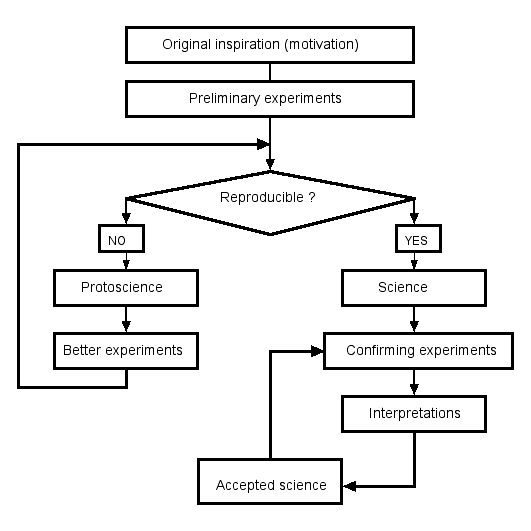
Figure 1
Schematic illustration of evolution of protoscience toward accepted science.
==============================
This study, prompted by recent reports (2,5), confirms that an unexpected nuclear process seems to be occasionally triggered by a chemical process. According to Oriani (2), whose protocol was used in my investigation, nuclear particles are emitted during and after electrolysis. The high level of reproducibility, according to him, is due to residual activity. Each consecutive electrolysis experiment presumably benefits from what happens during the previous experiment. The probability of triggering a CANR effect in a new electrolytic cell is said to be very low, but it becomes very high after the first success. The probability is also said to be high in a new cell containing o-rings used in successful experiments. That is why my experiments were performed with o-rings previously used by Oriani.
According to (2), distributions of tracks left by nuclear particles on CR-39 detectors are randomly uniform. But sometimes tracks appear in the form of clusters, as illustrated in Figure 2.
==============================
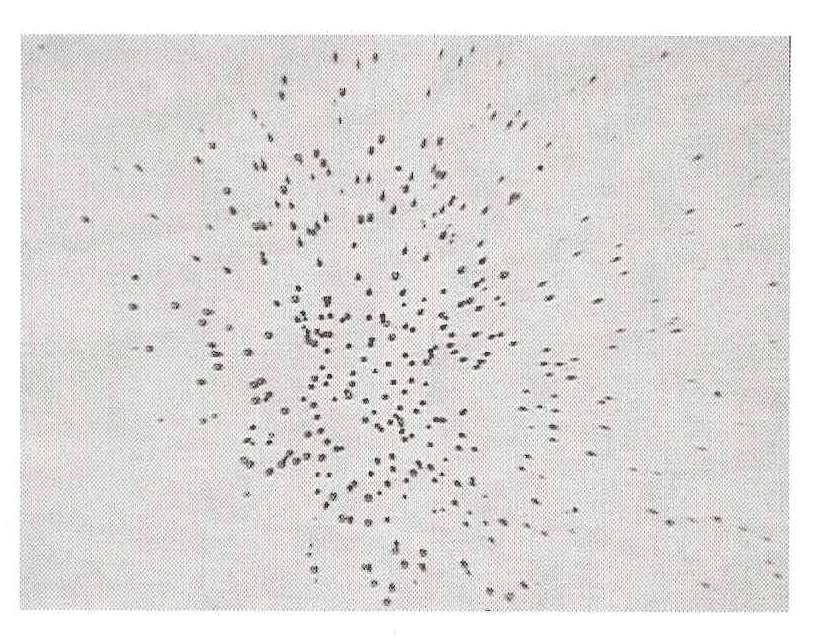
Figure 2
A cluster of post-electrolysis tracks discovered by Oriani (8). This cluster was produced when the CR-39 chip was exposed to an o-ring removed from the electrolytic cell. The mean density, about 30000 tr/cm2, is 2000 times higher than outside the cluster.
==============================
I was able to confirm occasional production of clusters at local densities much higher than the background. The densities of uniformly distributed tracks, however, were found to be consistent with the background. Can radioactivity acquired by these rings in Oriani’s cell be responsible for clusters produced in my experiments? My answer to this question will be negative. But the issue is far from being resolved, as indicated in the appendix. What follows describes my simple apparatus and results. In the closing section I will argue against the idea that clustered tracks are due to natural radioactivity or cosmic rays.
2) Experimental setup.
The electrolytic cell used in my experiments was identical to one of Oriani’s cells, as schematically illustrated in Figure 3A. The electrolyte was Li2SO4 in ordinary distilled water at a concentration of 22 grams per liter. The anode was Pt and the cathode was Ni. The cell consisted of a set of a glass tubes containing about 10 cc of the electrolyte. The bottom of the cell was made from a replaceable 3 by 3 cm piece of CR-39 plastic material. That piece (thickness about 1 mm) was separated from the electrolyte by a layer of mylar whose thickness was 6 microns. The Ni-wire cathode, in the form of a spiral pancake, was in contact with the mylar while the Pt-wire anode, also in the form of a spiral pancake, was about 15 mm above the cathode. The cell was designed in anticipation of experiments in which CR-39 would be removed and a silicon detector, placed below the mylar window, would be used to measure energies of charged nuclear particles.
Potential differences applied to the cell were between about 5 and 12 volts, depending on the desired current (between 30 mA and 150 mA during preliminary experiments). At 3 volts the current was close to zero. The concentration of the electrolyte was allowed to double (approximately) during experiments because water lost via electrolysis was usually not replaced until the volume of the electrolyte was reduced to approximately one half of the initial volume. The current, however, was kept constant, usually 42 mA, by an electronic stabilizer outside the power supply.
==============================
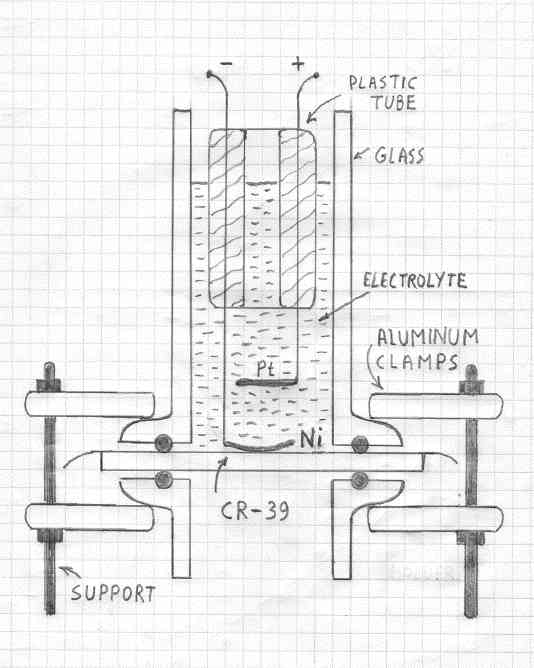 B ->
B -> 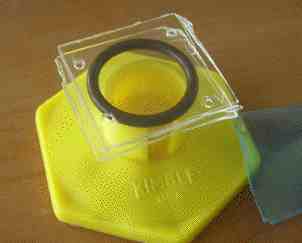
Figure 3
(A) Two flexible Viton o-rings are pressed against the CR-39 chip (by clamps applied to glass tubes) to prevent leakage of the electrolyte. The inner diameter of each tube was close to 15 mm; the wire diameters (Pt and Ni) were 0.5 mm. The Ni cathode was a “foot” supporting the rigid anode-cathode structure. (B) A CR-39 chip on top of an o-ring, as used to detect nuclear particles emitted after electrolysis.
==============================
The CR-39 chips were cut from a Fukuvi Chemical sheet purchased from Landauer Inc. (6). One of the well known properties of CR-39 material is its ability to record nuclear projectiles, such as protons or alpha particles (7). Tracks of such particles become microscopically visible after etching. Sizes of observed tracks increase with time and temperature of etching. A cluster consisting of over 100 tracks is shown in Figure 4. That figure is a microphotograph of a small area of CR-39 that was removed from the electrolytic cell after five days of electrolysis and etched for six hours. Round pits are tracks of particles that were intercepted at small angles of incidence; elliptical and conical pits are tracks of particles intercepted at larger angles. After twelve hours of etching nearly all tracks become round, as illustrated in Figure 5. Nuclear activity after electrolysis was studied by placing CR-39 chips on the o-rings removed from the cell, as illustrated in Figure 3B.
==============================
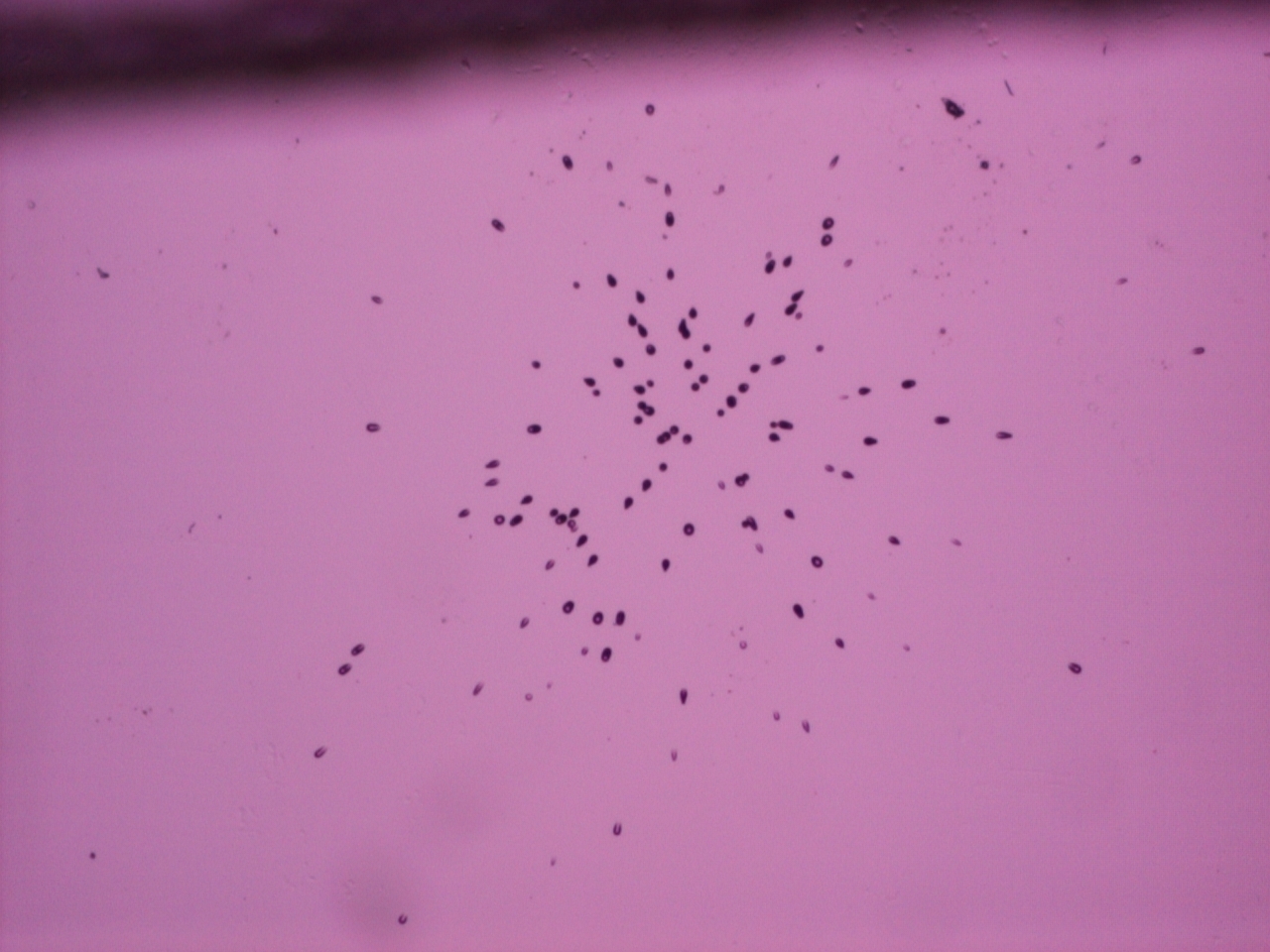
Figure 4
Cluster of tracks produced during five hours of electrolysis. The area of 1000 by 1300 microns was photographed under a magnification of X40, after six hours of etching. The mean track density, over the area of 1 mm2, is about 11000 tracks per cm2. This is three orders of magnitude higher than in the areas outside the four clusters, on the same CR-39 chip. A section of this photo, under a higher magnification, is shown in Figure 6.
==============================
All CR-39 detectors were etched for six hours in a small beaker. The average temperature was close to 72 C. But local temperatures, near individual detectors, were most probably not identical (because the etching solution was not stirred). Sizes of tracks are known to depend on the product to the etching time and temperature. It is reasonable to assume that observed difference in sizes and shapes of tracks, in different clusters, were due to differences in local temperatures. The effect of etching time on the tracks appearance can be seen by comparing Figure 4 and Figure 5.
==============================
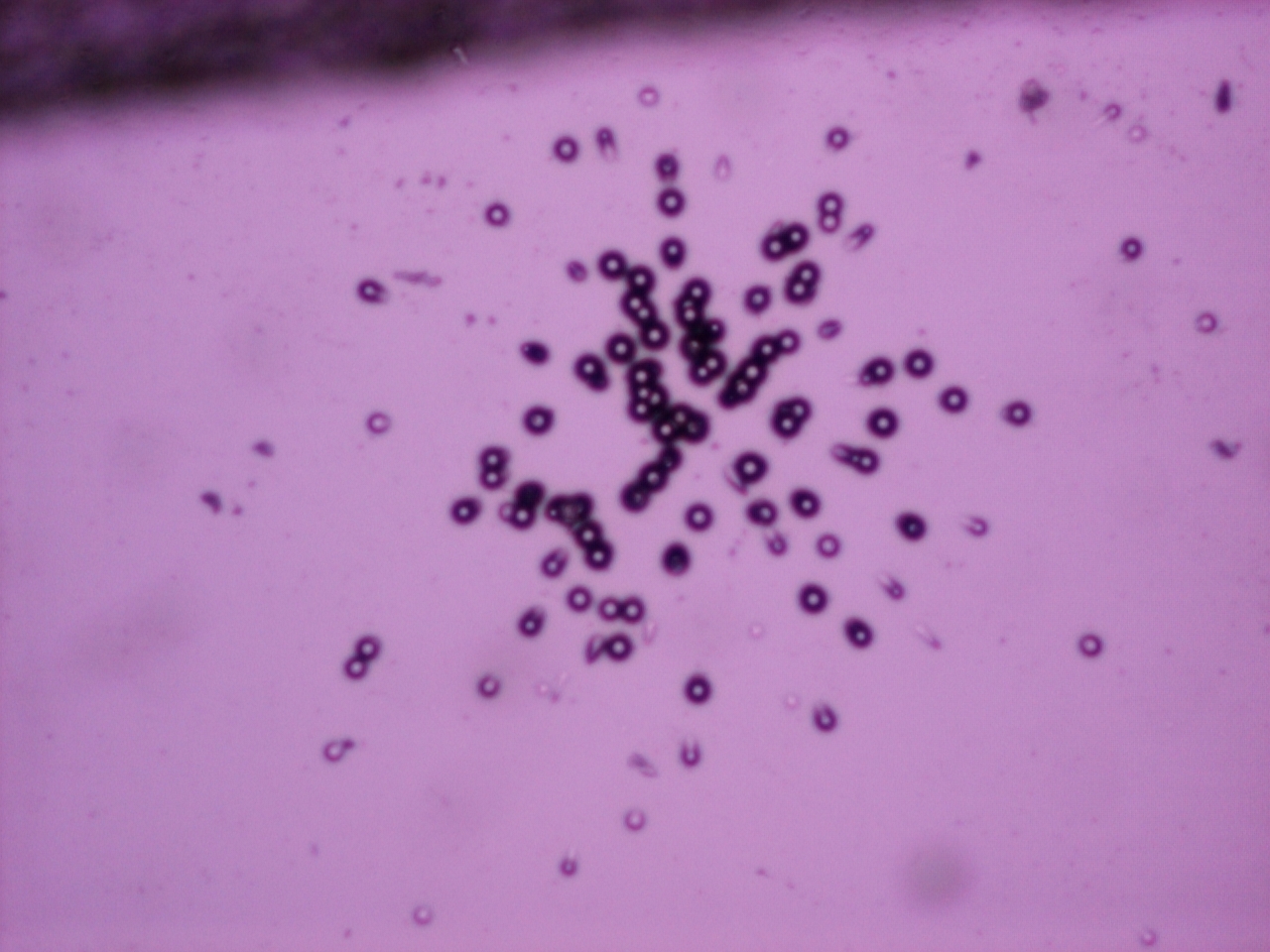
Figure 5
The microphotograph of the same cluster as in Figure 4 but after six additional hours of etching. As before, an area of 1000 by 1300 microns was photographed under a magnification of X40.
==============================
Control experiments with CR-39 chips in air showed that background track densities, after five days of exposure, fluctuated widely. The mean density was 15.5 tracks per square centimeter; the standard deviation was 9.7 tr/cm2. Similar densities were found on CR-39 chips exposed to the electrolyte, and to other unused components of the cell (glass, o-rings, platinum and nickel). Note that even 25 tr/cm2 density translates into 0.35 tracks per my low magnification field of 1.3 by 1.0 mm. In other words, fluctuations of background densities are inconsequential; local densities within clusters are usually much higher.
==============================
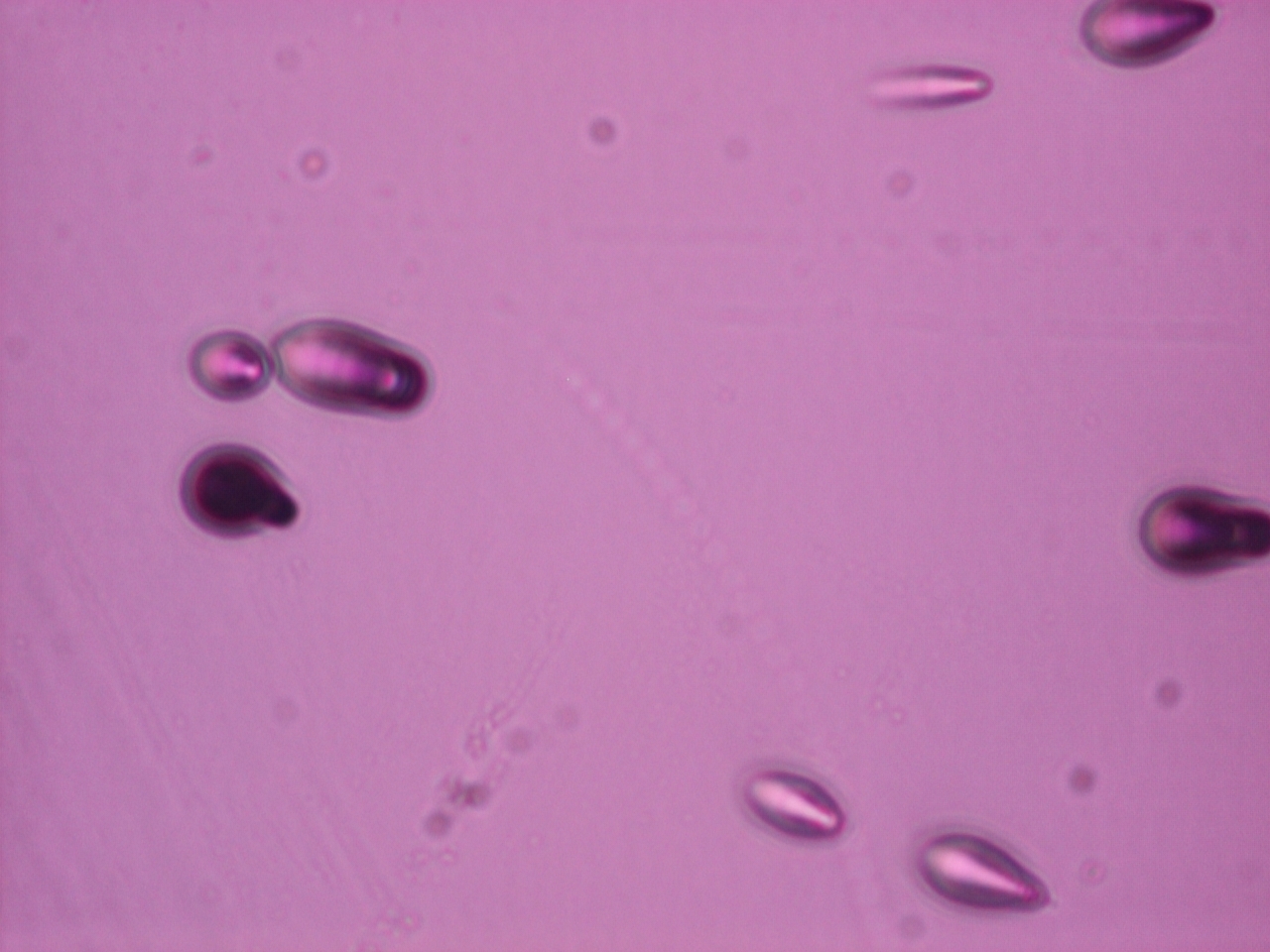
Figure 6
Elliptical and conical tracks in a small section of the area shown in Figure 4. The magnification was X400; the total photographed area was 130 by 100 microns.
==============================
3) Experimental results
Six experiments were performed to observe Oriani’s electrolysis effect. But only two of them were successful in terms of finding clusters of tracks. Two pictures of one post-electrolysis cluster are shown in Figures 4 and 5. Observed clusters are described in Table 1.
Table 1
Experiments to study nuclear particles emitted during electrolysis:
Electrolysis in Experiment I lasted 5 days, using Oriani’s seeded o-rings. The rings were received 24 hours after they were removed from Oriani’s cell. The experiment started shortly after the package arrived. Four clusters were produced. Numbers of tracks in these clusters were: 109, 75, 30, and 29. The corresponding mean track densities were: 11000, 5000, 3000, and 4800, respectively, per square centimeter.
Electrolysis in Experiment II lasted 21 days, using the same o-rings as in Experiment I. The experiment started shortly after the end of Experiment I. Zero clusters were produced.
Electrolysis in Experiment III lasted 5 days, using the same o-rings as in Experiment II. The experiment started shortly after the end of Experiment II. Three clusters were produced. Numbers of tracks in these clusters were: 85, 35, and 9. The corresponding mean track densities were 11000, 4400, and 900, respectively, per square centimeter.
Electrolysis in Experiment IV lasted 5 days, using another freshly seeded o-ring from Oriani. The experiment started shortly after that O-ring was received. Zero clusters were produced.
Electrolysis in Experiment V lasted 5 days, using the same o-ring as in Experiment IV. The experiment started shortly after Experiment IV. Zero clusters were produced.
Electrolysis in Experiment VI lasted 5 days, using the same o-ring as in Experiment V. The experiment started shortly after the end of Experiment V. Zero clusters were produced.
Experiments to study nuclear particles emitted after electrolysis:.
Experiment VII was conducted outside the electrolytic cell. Several small CR-39 chips were exposed to the o-ring used in Experiment III. The exposure time was two days; Zero clusters were produced.
Experiment VIII was also conducted outside the electrolytic cell. Two large CR-39 chips were applied to another freshly seeded o-ring sent to me by Oriani. Three clusters were produced during two days of exposure. Numbers of tracks in these clusters were: 110, 60 and 13 The corresponding mean track densities were 360, 300, and 2600, respectively, per square centimeter.
Experiment IX was similar to Experiment VIII, except that it started at the end of Experiment VIII. Zero clusters were produced during two days of exposure.
Experiment X was similar to Experiment IX, except that it started at the end of Experiment IX. Zero clusters were produced during two days of exposure.
But one cluster from Experiment III, shown in Figure 7, was very different. Similar patterns of nearby tracks, named rosettes, were reported by Oriani. He considers them to be part of background rather than clusters due to electrolysis. It is reasonable to assume that tracks in very small clusters are due to alpha particles emitted from a tiny grain of radioactive contamination, such as radium or uranium. This supposition is based on the fact that distances between radially oriented tracks are smaller than ranges of alpha particles in CR-39 or in the electrolyte (typically less than 50 microns). Peripheral tracks in Figure 4, on the other hand, are often separated by distances much larger than tracks of alpha particles. Significance of this observation will be discussed in the next section. It is remarkable that not a single cluster was found on more than twenty chips from control experiments. This is a strong indication that larger clusters are not due to background tracks.
==============================
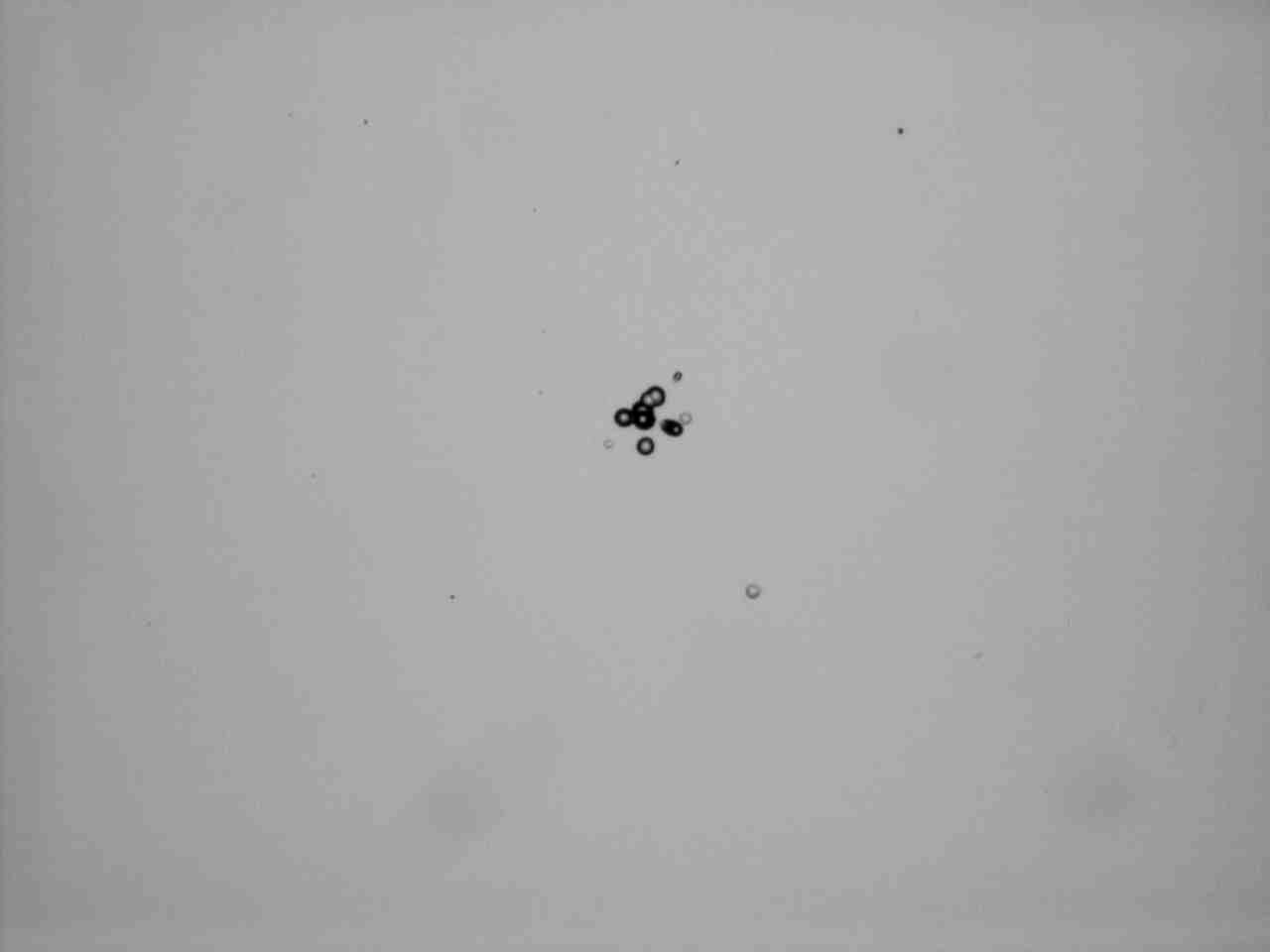
Figure 7
The microphotograph of a very small cluster of tracks produced in Experiment III. The photographed area was 1000 by 1300 microns; the magnification was X40.
==============================
4) Discussion
It is clear that random fluctuations could not be responsible for zero clusters in the Experiment II (electrolysis lasting 21 days ) and for four clusters in the Experiment I (electrolysis lasting five days). The same is true for clusters recorded after electrolysis. In both situations formation of clusters seems to be due to some uncontrollable factors. That is why further investigations are needed. In this section I want to show that neither contamination nor cosmic rays can be responsible for clusters shown in in Figures 1 and 4. The main argument is trivial -- ten clusters were produced on experimental chips and zero clusters were produced on all control chips.
Another argument against contamination is based on orientations of noncircular tracks. Orientations of these tracks, separated from each other by distances larger than ranges of alpha particles (in CR-39 and in water), would be random if clusters were due, for example, to large uranium particles. But orientations are certainly not random. Tracks near the centers of clusters are frequently round while tracks near peripheries are mostly elliptical. In fact, the average ellipticity seems to increase with the distance from the central region.
It is tempting to speculate that observed tracks result from collisions between protons in CR-39 (C12H18O7) and some kind of neutral particles. Neutral particles do not ionize matter directly; that is why they can travel long distances before colliding with protons. I am not going to elaborate on this because my goal, at this stage, is to convince myself (and others) that Oriani-type clusters are due to electrolysis. In that context it is important to mention that clusters were also reported by John Fisher (9) and by Marissa Little (10). The protocols used by these researchers were essentially the same as that used by Oriani. Clusters produced during electrolysis were also observed in SPAWAR experiments with sequential etching (11). Sequential etching was probably used to etch away myriads of chemically caused pits known to be present on the surface. Clusters with track deep inside the CR-39 material, if confirmed, would be highly significant. Note that SPAWAR experiments (5) were totally independent of Oriani's experiments, and of his protocol. Also note that in all cases local track densities, within clusters, were much higher than in the background.
Is it possible that observed clusters are due to cosmic rays? Collisions in which relativistic heavy ions disintegrate, producing showers of nucleons, have been studied using high energy accelerators, for example, at Brookhaven National Laboratory. Suppose that most of the tracks identified in Figure 4 are due to neutrons and protons resulting from the disintegration of a single ultra-relativistic ion, somewhere near the detector. What is the probability that such an ion can be found at sea level? Fortunately, this question has already been answered. According to (12), the theoretically calculated flux, for ions with Z=25, at sea level, is 10-34 particles per m2 per second. This amounts to about 3*10-21 particles per km2 per year. For particles with much higher Z the expected flux is many orders of magnitude smaller.
The second cosmic ray phenomenon to consider is showers. Primary cosmic ray charged particles, mostly protons, interact with the atmosphere by producing showers of pions and muons. Can a cluster seen in Figure 4 be due to such particles? The answer is a definite no. The ionization density of pions and muons is too low to produce tracks in CR-39 detectors. In one study (13), CR-39 chips were coated with fissionable material and exposed to beams of pions with several energies between 500 MeV and 2300 MeV. The purpose was to measure cross sections of fission induced by pions. This was done by counting tracks due to fission fragments. The reported cross sections indicate that billions of pions traverse CR-39 chips for each set of fission fragments. Observation of fission-fragment tracks would not be possible if individual pions could form tracks in CR-39 detectors.
On that basis I am inclined to conclude that clusters observed in my experiments were not due to cosmic rays, or to alpha-radioactive substances. Something interesting is going on and research in this controversial area should continue. The goal should be to identify hidden factors responsible for irreproducibility of experimental results. Unfortunately, present investigations of clusters belong to protoscience, as defined in Figure 1. Protoscience should not be confused with pseudoscience, such as astrology. Methods of validation in protoscience are not different from methods used in science.
Appendix (11/9/07):
Two important objections were made to my tentative conclusion that clusters could not be attributed to contamination with alpha-radioactive substances. The first objection
was made by Lipson and Rousetski, during a recent conference in Italy (14). Discussing my presentation, they invented the following scenario. A gas bubble sits on top of
CR-39. A grain of alpha-radioactive material sits on top of the bubble. Ranges of alpha particles in the gas bubble are much larger than in the electrolyte. That is why a
cluster can be much larger than ranges of alpha particles in the electrolyte. Furthermore, according to this assumption, most tracks would be circular near the central
region and noncircular along cluster's peripheries. Tracks along peripheries would be radially-oriented, more or less, as in our experimentally-observed clusters.
Commenting on the above S. Little wrote (15) “ . . . The electrolyte does not wet the CR-39. Grains of radioactive material could easily be trapped between the mylar film
and the CR-39, . . . “ In other words, not only bubbles can produce clusters with radially oriented tracks. I agree with these speculations.
References:
1) R. A. Oriani and J. C. Fisher: “Detection of energetic charged particles
during electrolysis;” Proceedings of ICCF10, 2003, pp 577-584. Also see
Jpn. J. Appl. Phys. 41,6180, 2002 and two papers in the proceedings of ICCf11, 2004, pp 281-303
2) Richard Oriani; submitted to Phys. Rev. C, October, 2007. Or draft of an unpublished manuscript, August 2007. That draft can be seen at:
http://csam.montclair.edu/~kowalski/cf/333oriani2007.html
3) A. G. Lipson et al., Proceedings of ICCF10, page 539 (2003). Also see
Fussion Tech. 38,238, (2000) and Bull. Lebedev Phys. Inst. 10, 22, (2001).
4) F.W. Keeney at al., Proceedings of ICCF10, page 509 (2003).
5) P.A. Mossier-Boss et al., “Production of high energy particles using the
Pd/D co-deposition process.” Paper presented at the APS meeting,
March 5, 2007, Denver Colorado. Also see Naturwissenschaften (2007) DOI 10.1007/g00114-007-0221-7.
6) Radon Division of Landauer Inc. (http://www.landauerinc.com/contact/)
7) D. Nikezic and K.N. Yub, “Formation and growth of tracks in nuclear track
materials” in Material Scince and Engineering, R46 (2004) p 51 to 123.
8) Personal information from R. Oriani; October 2007
9) Personal information from J. Fisher, cooperating with Oriani; October 2007
10) Personal information from M. Little, cooperating with Oriani; October 2007
11) Personal information from P. Boss, November 2007.
12) P.B. Price; “Do energetic heavy nuclei penetrate deeply into Earth’s
atmosphere?” Proc. Natl. Acad. Sci. USA, vol77, No 1, pp 44-48, January 1980
13) H.M. Khan et al., Nuclear Physics A vol 781, Issue 3-4, 15 January 207, pp 296-305.
14) The 8th International Workshop on Anomalies in Hydrogen- and Deuterium-Loaded Metals in Catania, Italy (October 2007).
15) Scott Little, Earthtech International, Inc. (in a message posted on the private Internet list for CMNS researchers, 11/8/07).
Click to see the list of links